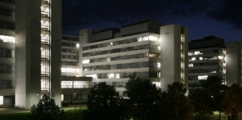CeBiTec Colloquium
| date | Monday, October 4th 2010, 17 c.t. | |
| location | G2-104, CeBiTec Building | |
| speaker | Dr. Sebastian LeidelMax-Planck-Institut für molekulare Biomedizin, Münster | |
| title | Urm1p at the crossroads of modifications | |
| Ubiquitin-like proteins (UBLs) can change protein function, localization or turnover by covalent attachment to lysine residues. While UBLs achieve this conjugation via an intricate enzymatic cascade, their bacterial counterparts MoaD and ThiS function as sulfur-carrier proteins. We identified the URM1-pathway as required for the thiolation of three cytoplasmic tRNA species in yeast by systematic genetic analysis (SGA). Furthermore, we showed that Urm1p, the most ancient UBL, acts as a sulfur-carrier in this process independent of its function as a protein modifier. Thus, Urm1p might provide an evolutionary link between UBL and sulfur transfer. Moreover, we identified Uba4p, Ncs2p, Ncs6p and Tum1p as components of this conserved pathway. We could show that Ncs2p and Ncs6p interact and that Ncs6p as well as TUT-1 its homologue in Caenorhabditis elegans can bind tRNA in vitro. Furthermore, we show that Uba4p first adenylates and then directly transfers sulfur onto Urm1p. Finally, functional analysis revealed that the thiolation function of Urm1p is critical to regulate cellular responses to nutrient starvation and oxidative stress conditions, most likely by increasing translation fidelity. Based on our findings we are currently establishing techniques that will allow for an unbiased analysis of how of RNA modification defects lead to the plethora of phenotypes, which are observed in mutants defective in RNA modification pathways. | ||
| host | Prof. Dr. Jens Stoye |



